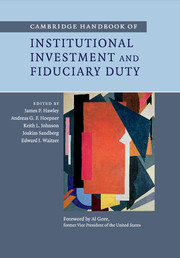Book contents
- Frontmatter
- Contents
- List of figures
- List of tables
- List of contributors
- Foreword
- 1 Introduction
- Part I Fiduciary duty: a global outlook
- Part II Fiduciary duty and the landscape of institutional investment
- Part III Challenging conventional wisdom on fiduciary duty
- 14 Is the search for excessive alpha a breach of fiduciary duty?
- 15 Fiduciary duty and sin stocks:is vice really nice?
- 16 Whose risk counts?
- 17 Sustainability, financial markets and systemic risk
- 18 Uncertain times, plural rationalities and the pension fiduciary
- 19 Emotional finance and the fiduciary responsibility of asset managers
- Part IV Towards a broader interpretation of fiduciary duty
- Part V Beneficiaries’ roles and viewpoints
- Part VI Fiduciary duty and governance
- Index
- References
15 - Fiduciary duty and sin stocks:is vice really nice?
Published online by Cambridge University Press: 05 April 2014
- Frontmatter
- Contents
- List of figures
- List of tables
- List of contributors
- Foreword
- 1 Introduction
- Part I Fiduciary duty: a global outlook
- Part II Fiduciary duty and the landscape of institutional investment
- Part III Challenging conventional wisdom on fiduciary duty
- 14 Is the search for excessive alpha a breach of fiduciary duty?
- 15 Fiduciary duty and sin stocks:is vice really nice?
- 16 Whose risk counts?
- 17 Sustainability, financial markets and systemic risk
- 18 Uncertain times, plural rationalities and the pension fiduciary
- 19 Emotional finance and the fiduciary responsibility of asset managers
- Part IV Towards a broader interpretation of fiduciary duty
- Part V Beneficiaries’ roles and viewpoints
- Part VI Fiduciary duty and governance
- Index
- References
Summary
Introduction
Based on a conservative interpretation of fiduciary duty, pension funds are considered to arrive at investment decisions purely based on the financial performance of the underlying assets. Hence, whatever the real world implications of the asset, trustees following this view are legally obliged to invest as long as the expected returns in financial markets are abnormally high (Entine 2005; Munnel and Sundén 2005; Rounds 2005). Practically, this means that they have to speculate with soft commodities and thereby potentially drive basic food prices so high that the poorest on this planet can barely afford two meals a day. More paradoxically, a pension fund representing health care workers is legally obliged to invest substantially in alcohol, tobacco or gambling companies, so called “sin stocks,” should they be associated with an abnormally high return. Even the Freshfields Report, a rather liberal interpretation of the constraints that fiduciary duty imposes on pension funds aiming to consider social criteria in their decision-making, can hardly be interpreted as recommendation to ignore financially well-performing stocks on moral grounds. Its most liberal conclusion is that social criteria may be considered by pension funds if they do no financial harm, which effectively prohibits underweighting or excluding well-performing sin stocks (Freshfields Bruckhaus Deringer 2005).
Hence, the question is, can undesirable assets such as soft commodities or sin stocks reasonably be expected to experience an abnormally good financial performance? While we are not aware of such evidence for soft commodities, there is a very prominent academic study finding portfolios of sin stocks to have a superior financial performance: Hong and Kacperczyk (2009). This study has been discussed in various mainstream media sources such as Financial Times, Forbes, Reuters or the Wall Street Journal. As a result, pension funds are in a dilemma: many stakeholders – although not necessarily all members – put pension funds under considerable pressure to act with a social consciousness, while the mainstream media celebrates sin stocks for their financial performance and hence fiduciary duty obliges them to invest in these over-proportionally.
- Type
- Chapter
- Information
- Publisher: Cambridge University PressPrint publication year: 2014
References
- 3
- Cited by



